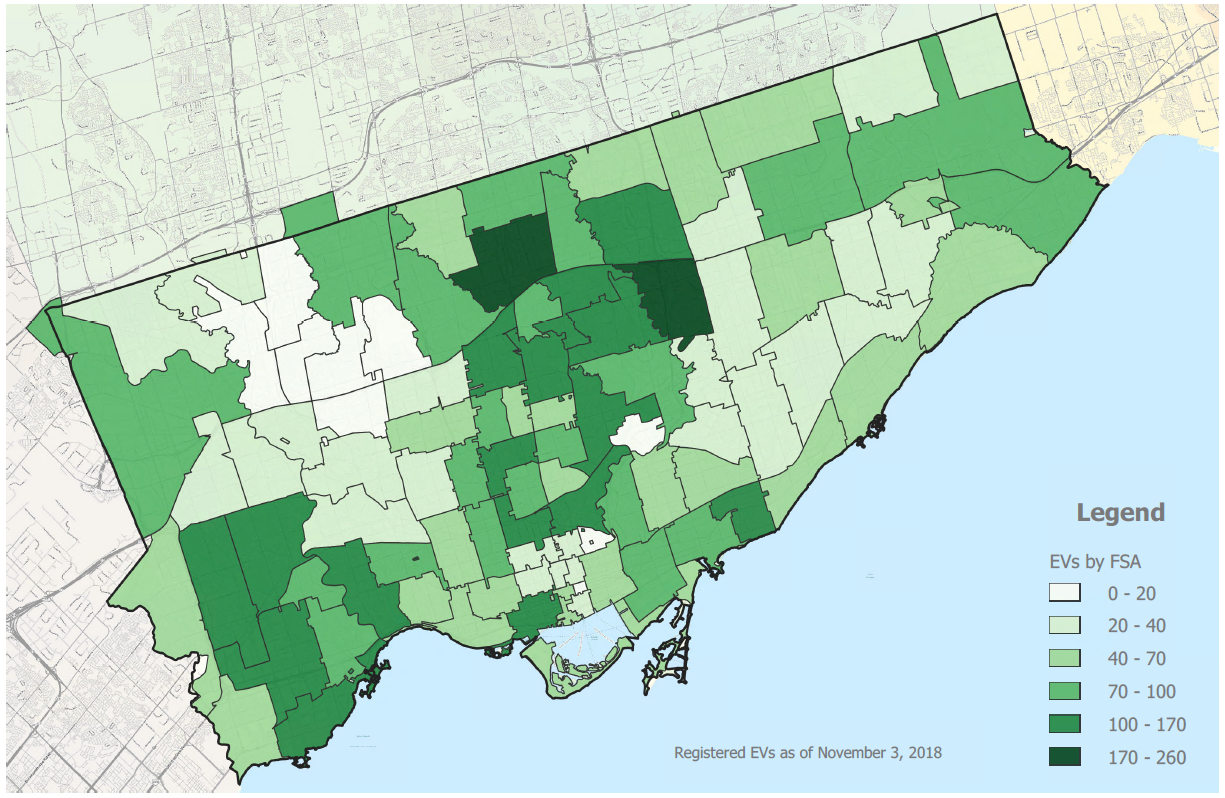By Derek May, Project Manager at Pollution Probe
The City of Toronto has just completed the Assessment Phase of its Electric Mobility Strategy, which is a key component of its climate action strategy, TransformTO. TransformTO contains a wide variety of ambitious transportation and greenhouse gas (GHG) related targets, including:
- Transition 100% of transportation modes to low or zero carbon energy by 2050
- Ensure at least 75% of trips less than 5 km are completed using active transportation by 2050
- Transition 45% of the City’s fleet vehicles to low-carbon alternatives by 2030
The Assessment Phase was undertaken to provide Toronto with an authoritative summary of the current electric mobility landscape. The City contracted Pollution Probe and The Delphi Group to lead the development of the Assessment Phase.
We consulted with a wide variety of experts and dug into a wide range of pressing issues during the Assessment Phase, the results of which will provide a foundation for the Electric Mobility Strategy. Our full report can be accessed from Pollution Probe’s website, but here are some highlights:

Image: Current electric vehicle ownership levels in Toronto, by Forward Sortation Area (first three postal code digits)
Torontonians buy electric vehicles for cost as well as environmental reasons
Our research found that Torontonians are buying EVs due to lower maintenance and fueling costs as well as environmental benefits. While internal combustion engine (ICE) vehicles have somewhere in the neighbourhood of 2,000 moving parts, EVs tend to have about 20. With far fewer moving parts, the odds of something breaking down in an EV are greatly reduced. Most of the maintenance that is routine with ICE vehicles is simply not required with an EV. Changing oil, transmission fluid, engine coolant, fan belts, engine air filters, spark plugs, etc., is a thing of the past to EV owners. Even brake pads on EVs last a lot longer due to regenerative braking.
Regarding environmental benefits, anyone who lives in a city like Toronto has experienced first-hand the stinky, choking exhaust being belched out by ICE vehicles on busy urban streets and highways. This exhaust not only contributes to climate change and smog formation, but also has serious human health impacts and can lead to breathing problems, heart disease, cancer, and even premature death. A few grim statistics on this topic:
- 1,300 premature deaths and 3,550 hospitalizations are attributable to air pollution in Toronto each year
- Health impacts are greatest on people who live or work close to major roads, and are most pronounced in youths, the elderly, and those with pre-existing health conditions
- Health costs stemming from traffic-related air pollution in Canada were over $32 billion in 2010
Well-off male commuters are buying electric vehicles
Our research into EV ownership demographics produced some interesting results. Toronto’s EV owners tend to be:
- Well-educated (40% have a graduate-level degree)
- Affluent (average household incomes of $114,000 compared to $83,000 for ICE vehicle owners)
- Owners of detached, single-family homes
- Men (a disproportionately high 75% of Toronto EV owners are male)
- Longer-distance commuters (46 km average commute versus 32 km for ICE vehicle owners)
EV adoption in Toronto being held back by high purchase costs
Not surprisingly, the old capitalist adage “cost is king” holds true when it comes to vehicle purchasing decisions. When the total cost of ownership of a given vehicle is calculated, EVs often come out ahead of ICE vehicles (depending on driving patterns, time of charging, etc.). Unfortunately, however, few vehicle owners take the time to do a little back of the envelope number crunching, and instead focus primarily on a vehicle’s sticker price.
Other prominent barriers to EV ownership in Toronto, which the report provides potential solutions for, were found to be:
- Lack of charging infrastructure (both in public and in multi-unit residential buildings), and consumer awareness of charging options
- General lack of knowledge and understanding regarding electric mobility
- Limited EV supply and long wait times (the most popular types of vehicles in Ontario are passenger light trucks – SUVs, minivans, and pickups – and there are currently few EV offerings within these vehicle segments)
Looking forward…
The City of Toronto is taking action on many different fronts to address transportation emissions. The Toronto Transit Commission (TTC) has committed to buying only zero-emission buses starting by 2025, leading to an emissions-free bus fleet by 2040. The City has initiated on-street EV charging pilot projects aimed at neighbourhoods where street parking is the only option for residents, and will also install over 200 EV chargers at its public “Green P” parking lots. It is working on a strategy for the eventual integration of autonomous vehicles, and also introduced a requirement that taxis be replaced with alternative fuel or hybrid vehicles when they reach the end of their lives. Further, Toronto is working to ensure that EV charging is available in residential buildings, commercial sites and City-owned buildings.
The Assessment Phase report addresses many other aspects of the transition to electric mobility in Canada’s biggest city, and we invite you to take a closer look at it. The Electric Mobility Strategy itself is currently under development, and should be officially released in the fall of 2019.
Derek can be reached at dmay@pollutionprobe.org
Editor’s note: TAF sits on the City of Toronto EV Working Group, which is helping to create the Electric Mobility Strategy.
